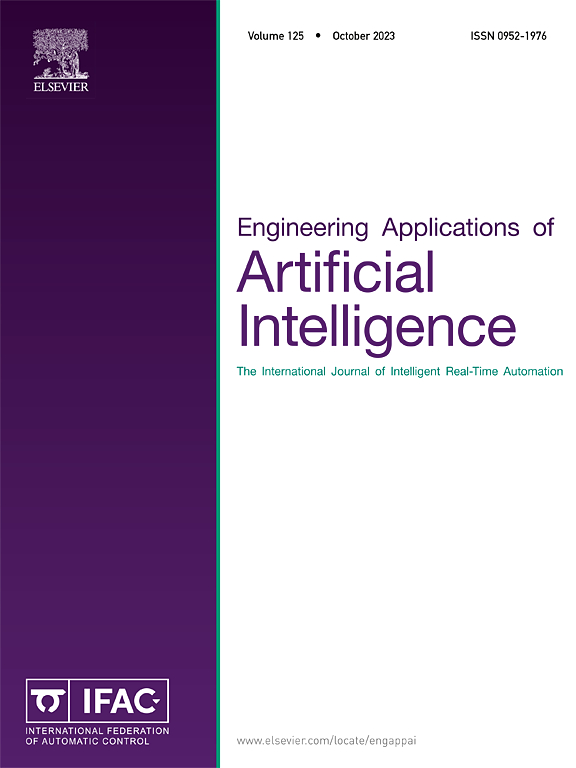Interpretable adaptive multiwavelet kernel-driven two-dimensional convolutional neural network for mechanical fault diagnosis
IF 8
2区 计算机科学
Q1 AUTOMATION & CONTROL SYSTEMS
Engineering Applications of Artificial Intelligence
Pub Date : 2025-07-02
DOI:10.1016/j.engappai.2025.111614
引用次数: 0
Abstract
Despite extensive research on convolutional neural networks (CNNs) for intelligent fault diagnosis, several challenges remain, including the limited effectiveness of one-dimensional CNNs, susceptibility to noise, and lack of interpretability. To address these issues, an interpretable adaptive multiwavelet kernel-driven two-dimensional convolutional neural network model called MWKN has been designed for mechanical fault diagnosis in this paper. Specifically, a newly designed adaptive natural convolutional layer based on two-dimensional multiwavelet transform is embedded as a feature extraction module in the shallow layer of a two-dimensional CNN model. Crucially, this novel multiwavelet convolutional layer is jointly optimized with the entire network, enabling the adaptive optimization of its intrinsic multiwavelet convolutional kernel. Additionally, this model incorporates a specifically designed embedded two-dimensional neighboring coefficient shrinkage module to address the issue of CNN susceptibility to strong noise. This study investigates the interpretability of the MWKN model through simulated fault experiments, addressing interpretability deficits observed in CNN. The results demonstrate that the embedded multiwavelet kernel and the inclusive WMKN model as a whole possess synchronized learning and matching rules, substantiating that the learning process of the multiwavelet kernel is neither isolated nor random but follows an inherent adaptive learning mechanism based on the principle of error minimization. Finally, the excellent fault identification capability and robust noise resistance of MWKN are validated through experimental cases of variable speed bearing faults and pump circulation bearing faults under strong noise background. In addition, the industrial applicability and interpretability of the method were further validated in an industrial scenario case.
用于机械故障诊断的可解释自适应多小波核驱动二维卷积神经网络
尽管卷积神经网络(cnn)在智能故障诊断方面进行了广泛的研究,但仍然存在一些挑战,包括一维cnn的有效性有限,易受噪声影响以及缺乏可解释性。为了解决这些问题,本文设计了一种可解释的自适应多小波核驱动的二维卷积神经网络模型MWKN,用于机械故障诊断。具体而言,将基于二维多小波变换的自适应自然卷积层作为特征提取模块嵌入到二维CNN模型的浅层。重要的是,这种新的多小波卷积层与整个网络共同优化,使其固有的多小波卷积核能够自适应优化。此外,该模型采用了专门设计的嵌入式二维相邻系数收缩模块,以解决CNN对强噪声的敏感性问题。本研究通过模拟断层实验研究了MWKN模型的可解释性,解决了CNN中观察到的可解释性缺陷。结果表明,嵌入的多小波核和包容性WMKN模型整体上具有同步学习和匹配规则,证明了多小波核的学习过程既不是孤立的,也不是随机的,而是遵循基于误差最小化原则的内在自适应学习机制。最后,通过强噪声背景下变速轴承故障和泵循环轴承故障的实验案例,验证了MWKN具有优异的故障识别能力和鲁棒的抗噪声能力。此外,在工业场景案例中进一步验证了该方法的工业适用性和可解释性。
本文章由计算机程序翻译,如有差异,请以英文原文为准。
求助全文
约1分钟内获得全文
求助全文
来源期刊

Engineering Applications of Artificial Intelligence
工程技术-工程:电子与电气
CiteScore
9.60
自引率
10.00%
发文量
505
审稿时长
68 days
期刊介绍:
Artificial Intelligence (AI) is pivotal in driving the fourth industrial revolution, witnessing remarkable advancements across various machine learning methodologies. AI techniques have become indispensable tools for practicing engineers, enabling them to tackle previously insurmountable challenges. Engineering Applications of Artificial Intelligence serves as a global platform for the swift dissemination of research elucidating the practical application of AI methods across all engineering disciplines. Submitted papers are expected to present novel aspects of AI utilized in real-world engineering applications, validated using publicly available datasets to ensure the replicability of research outcomes. Join us in exploring the transformative potential of AI in engineering.
 求助内容:
求助内容: 应助结果提醒方式:
应助结果提醒方式:


